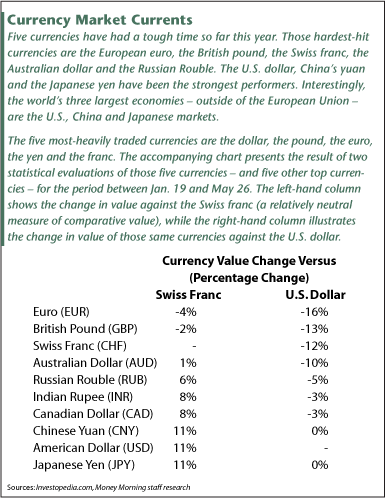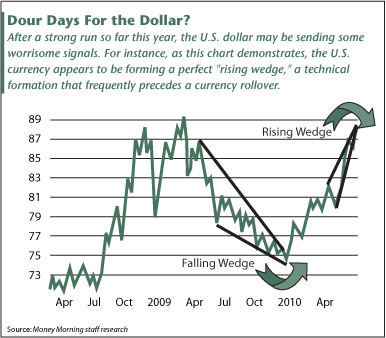The U.S. dollar has been one of the world's strongest currencies in the first part of 2010, posting double-digit gains through the end of May.
And little wonder. The Greek debt crisis continues to threaten Europe's overall health, and could unleash an entirely new contagion on the rest of the global economy. Then there's China, - the engine of world growth during much of the financial crisis - which now appears to face the near-term triple threat of slowing growth, accelerating inflation and workplace unrest. Add in concerns about commodity prices and global debt levels and it's easy to see why currency investors have sought the safe haven of the U.S. dollar.
In short, it appears that "everybody" knows the greenback is the best choice for safety, quality and security.
But is that really the case? To me, the dollar is looking more and more like a colossal short that could wind up being one of the biggest moneymakers of the year for traders gutsy enough to take a stand.
From Leader to Laggard?
Given that the dollar soared 11% through the end of May (see accompanying graphic), I'm sure some experts will call me crazy for going against the dollar at this point in history. But here's my thinking:

- Our $14 trillion fiscal hangover, weaker-dollar policies and increased spending will lead to additional dollar weakness in the immediate term. Longer-term, this is a foregone conclusion: The high debt load relative to U.S. gross domestic product will erode growth - studies prove this - and all the extra money that we've printed will fuel inflation, as always happens..
- Foreign central bankers - especially China - are actively diversifying away from dollar reserves and dollar-denominated securities. They can't and won't "dump" the dollar in a wholesale manner. But this shift away is nothing less than a long-term decrease in demand for the dollar - and we all know that when demand for an asset declines, so does its value.
- The Organization of the Petroleum Exporting Countries (OPEC) - and what's left of the non-OPEC nations - are still pressing for non-dollar-denominated oil deals. Expect some of those deals to take place in the wake of the BP PLC (NYSE ADR: BP) Deepwater Horizon disaster, which will bring about major regulatory changes and cause onshore reserves to command a major premium. This group, incidentally, isn't to be dismissed, given that it contains such heavyweights as China, Japan, Russia, most of the Arab nations and, of course, France.
- If you look at the following chart of the U.S. dollar, you can see that appears to be forming a perfect "rising wedge," a technical formation and a bearish signal that frequently precedes rollovers. That's the opposite of a "falling wedge," a bullish signal that presages reversals to the upside.

How to Play the Dollar's Reversal
It's worth noting here that this wager against the U.S. dollar should be viewed for just what it is - a highly speculative trade. This means it's only for aggressive traders.
Keep in mind, too, that the dollar won't shed its reputation as the currency of last resort without a struggle. Negative events abroad could send investors back into the currency for short stretches, making the dollar prone to short, rapid increases in value, despite its highly flawed underpinnings.
Position traders and everyday investors will probably want to wait for confirmation that the dollar's trend is, indeed, reversing. We've seen some of that in the past two days but more is probably on the way. You'll miss out on some returns but that's the way the game is played - you have to act on your convictions or else you're simply another wannabe in this business.
My suggestion is that any speculative trade be limited to 2% of investable capital. That way, if we're wrong and the dollar doesn't cooperate, the risk to your portfolio is minimized.
As for suitable ways to play this dour-dollar prediction, I can think of three:
- Go for the Gold: This is so obvious that I'm almost deterred from suggesting it, especially since the yellow metal is once again trading near its all-time highs. Generally speaking, I don't like buying anything at all-time highs, meaning that pullbacks are the key here. I expect $2,000-an-ounce gold within the next couple of years - and possibly sooner - depending on how central bankers choose to deal with the EU and how the U.S. Federal Reserve handles the recovery bailout "exit" strategies it's alluded to in recent months.
- Take "The Natural" Approach: By "natural approach," I'm referring, of course, to natural resources. The BP situation - coupled with new drilling restrictions and increasing Third World demand - is going to push the price of oil and other resources much higher. It's not clear which one pulls or pushes lately - the U.S. dollar or oil - but when one moves the other generally heads in the opposite direction immediately. So watch the relationship between the two carefully to spot when this trend gets under way. Be prepared for some volatile trading, though. Silver, gold and other resources can move 5%, 8% and even 10% in a single day.
- Cash in on Currency Funds: It used to be that the dollar and the euro were the world currency market's "dynamic duo" - when one went, you could count on trading the other. But I think that relationship is long gone. The money has now shifted across the Atlantic, headed through the U.S. economy, and headed straight for Asia. As a result, instead of shorting the euro, I'm now inclined to short the dollar, while being generally long on the Hong Kong dollar, the Australian dollar and even the Chinese yuan.
[Editor's Note: Money Morning's Keith Fitz-Gerald is still perfect.
With his latest trade, Fitz-Gerald is a perfect 23 for 23 with his Geiger Index advisory service. A veteran trader, skilled analyst and noted market tactician, Fitz-Gerald is able to see through the confusing haze of today's quickly changing markets, which enables him to visualize and understand what the future holds. This ability to see into the future -predicting looming changes while also divining the profit opportunities those changes will create - is one of Fitz-Gerald's greatest strengths.
That's a big reason that Fitz-Gerald - Money Morning's chief investment strategist and the editor of the New China Trader advisory service - has maintained a perfect record with the Geiger Index.
If you would like more information about the Geiger Index, please click here.
And if you'd like to check out Fitz-Gerald's portfolio-strategy story, which appears elsewhere in today's issue of Money Morning , please click here.]
News and Related Story Links:
- Money Morning Defensive Investing Series (Keith Fitz-Gerald Q&A):
Top Profit Plays for a Defensive-Investing Portfolio - Money Morning Defensive Investing Series:
The 50-40-10 Investment Strategy Pays Off in Profits, Protection & Potential
- OPEC.org:
Official Website - Money Morning Special Research Report:
Gold Prices Soar to Record High on Report of Secret Plan to Dethrone the Dollar
- Money Morning Special Investment Report:
Two Energy Stocks For a Post-Oil-Spill World - Money Morning Special Report:
Oil Sector Expert Kent Moors Sees Tough Times, Stricter Regs For BP After Oil Spill
- Money Morning Defensive-Investing Series:
How the Greece Bailout Turned Gold Into a 'Must-Have' Investment - Money Morning News Analysis:
Gold Prices Surge and Will Keep Climbing as Investors Protect Against European Debt Crisis - Wikipedia:
Batman
- Money Morning News Archive:
Articles About Greece
About the Author
Keith is a seasoned market analyst and professional trader with more than 37 years of global experience. He is one of very few experts to correctly see both the dot.bomb crisis and the ongoing financial crisis coming ahead of time - and one of even fewer to help millions of investors around the world successfully navigate them both. Forbes hailed him as a "Market Visionary." He is a regular on FOX Business News and Yahoo! Finance, and his observations have been featured in Bloomberg, The Wall Street Journal, WIRED, and MarketWatch. Keith previously led The Money Map Report, Money Map's flagship newsletter, as Chief Investment Strategist, from 20007 to 2020. Keith holds a BS in management and finance from Skidmore College and an MS in international finance (with a focus on Japanese business science) from Chaminade University. He regularly travels the world in search of investment opportunities others don't yet see or understand.



